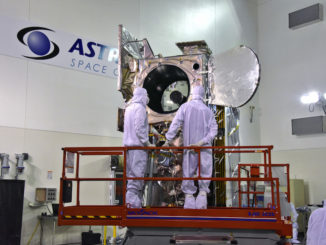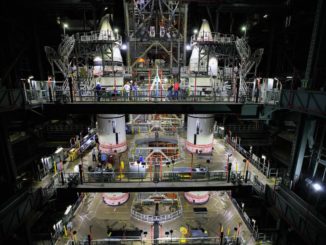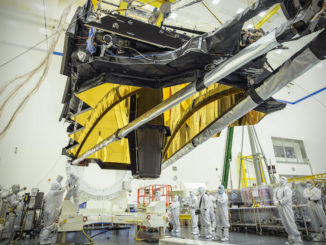
An electrical problem on one of the Ariane 5 rocket’s two solid rocket boosters led to an on-pad launch abort Tuesday, likely delaying liftoff with two U.S.-built communications satellites until around the end of September, Arianespace officials said.
Tuesday’s launch was halted seconds before liftoff, with the Ariane 5’s Vulcain 2 main engine already burning. A computer-run health check of the engine and other launcher systems turned up an anomaly affecting electrical equipment on one of the Ariane 5’s solid rocket boosters, Arianespace said.
“This interruption is perfectly compliant with our procedures which authorize a launch only if 100 percent of launcher equipment is fully operational,” Arianespace said in a statement. “This rule guarantees the reliability and robustness of our launch system.”
The launch team safed and secured the Ariane 5 rocket and its two satellite payloads — the Intelsat 37e and BSAT 4a communications spacecraft — in the aftermath of the last-second abort.
“An analysis started immediately after the countdown interruption,” Arianespace said. “It will continue to identify the anomaly’s cause and determine the measures to be taken in order to resume launch operations as soon as possible.”
Ground crews removed the Ariane 5 rocket Thursday from its launch pad at the Guiana Space Center, a French-run spaceport in French Guiana. A diesel-powered tug towed the rocket and its mobile launch platform back to the spaceport’s final assembly building along 1.7 miles (2.7 kilometers) of rail tracks.
“As soon as the analysis of the anomaly has been completed, Arianespace will announce a new launch date,” the French launch operator said in a statement. “The objective is to launch around the end of September 2017.”
Along with making repairs to the solid rocket booster’s electrical system, technicians will reconnect two umbilical arms to the Ariane 5’s upper stage. The connectors feed cryogenic liquid hydrogen and liquid oxygen propellants to the second stage tanks, but they retracted as planned during the final seconds of the countdown.
The umbilical arms require manual reconnection to the launcher.
The launch team depressurized the rocket’s tanks after Tuesday’s scrub, then drained propellants before rollback to the Ariane 5 hangar. The rocket has special propellant drainage lines from the upper stage that are designed for use in the event of an aborted countdown.

The Intelsat 37e and BSAT 4a satellites are expected to remain aboard the rocket until the next launch attempt.
The 14,193-pound Intelsat 37e satellite, occupying the upper position in the Ariane 5’s dual-payload stack, will beam broadband, wireless communications, television and government services across the Americas, the Atlantic Ocean, Europe and the Middle East from a perch in geostationary orbit at 18 degrees west longitude. Made by Boeing in El Segundo, California, Intelsat 37e is the fifth Epic-series satellite launched for Intelsat.
BSAT 4a will provide HD, 4K and 8K Ultra HD television broadcasts over Japan for Broadcasting Satellite System Corp. The satellite was built by Space Systems/Loral in Palo Alto, California, and carries 24 Ku-band transponders.
Arianespace expects no ripple effects in its manifest from this month’s delayed launch.
A lightweight Vega launcher is scheduled for liftoff from French Guiana on Nov. 8 at 0142:30 GMT (8:42:30 p.m. EST on Nov. 7) with a spy satellite for the Moroccan government. One more Ariane 5 launch this year is slated for Dec. 12 at 1836:07 GMT (1:36:07 p.m. EST) with four European Galileo navigation satellites.
Email the author.
Follow Stephen Clark on Twitter: @StephenClark1.



